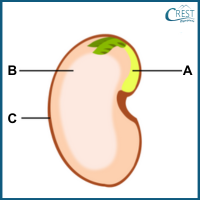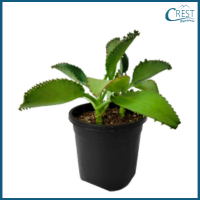1. Identify and label the part of the seed that grows up to be a new plant.

a) C: Seed coat
b) A: Cotyledon
c) A: Embryo
d) B: Embryo
Answer: c) The embryo is the part of the seed that develops into a new plant. It contains the essential structures needed for the plant's growth, such as the shoot tip, root tip, and the first leaves.
2. Which of the following is an example of reproduction through vegetative propagation?
a) Planting a seed in the soil
b) Cutting a stem from a parent plant and planting it in the soil
c) Pollinating a flower
d) Spreading seeds through the wind
Answer: b) Vegetative propagation refers to the reproduction of plants using vegetative parts, such as stems, leaves, or roots, rather than seeds. Cutting a stem from a parent plant and planting it in the soil is an example of vegetative propagation.
3. Suppose you have a healthy rose plant with beautiful red flowers, but its stem is weak and prone to breaking. Which method of propagation would you use to create a new rose plant that has the same beautiful flowers but a strong and sturdy stem?
a) Grafting a stem cutting from another rose plant onto the weak stem
b) Planting rose seeds and waiting for them to germinate
c) Bending a low-lying branch into the soil and allowing it to root
d) Collecting leaves from the rose plant and planting them to produce new plants
Answer: a) Grafting allows us to combine the strong and sturdy stem of one rose plant with the beautiful red flowers of another. By attaching a stem cutting from a healthy rose plant onto the weak stem, we can create a new rose plant that has both the desired flower colour and a stronger stem to prevent breakage.
4. Which method of vegetative propagation is used to create a new plant shown in the picture?

a) Planting its seeds
b) Grafting a branch onto another plant
c) Taking a stem cutting from an existing plant
d) Budding from leaves
Answer: d) Bryophyllum plant shown in the picture reproduces through vegetative propagation by budding from leaves. In this method, new plants are formed when buds emerge from the notches in the leaf margins and develop into independent individuals.
5. How do plants reproduce through layering?
a) By cutting a stem from the parent plant and planting it in the soil
b) By bending a branch into the soil and covering it with moist soil
c) By attaching a scion to a stock and fusing their tissues together
d) By collecting and sowing seeds from mature plants
Answer: b) Plants reproduce through layering by bending a branch of the parent plant into the soil and covering it with moist soil.



